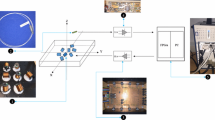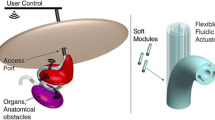Abstract
Purpose
Robotic and mechatronic devices that work compatibly with magnetic resonance imaging (MRI) are applied in diagnostic MRI, image-guided surgery, neurorehabilitation and neuroscience. MRI-compatible mechatronic systems must address the challenges imposed by the scanner’s electromagnetic fields. We have developed objective quantitative evaluation criteria for device characteristics needed to formulate design guidelines that ensure MRI-compatibility based on safety, device functionality and image quality.
Methods
The mutual interferences between an MRI system and mechatronic devices working in its vicinity are modeled and tested. For each interference, the involved components are listed, and a numerical measure for “MRI-compatibility” is proposed. These interferences are categorized into an MRI-compatibility matrix, with each element representing possible interactions between one part of the mechatronic system and one component of the electromagnetic fields. Based on this formulation, design principles for MRI-compatible mechatronic systems are proposed. Furthermore, test methods are developed to examine whether a mechatronic device indeed works without interferences within an MRI system. Finally, the proposed MRI-compatibility criteria and design guidelines have been applied to an actual design process that has been validated by the test procedures.
Results
Objective and quantitative MRI-compatibility measures for mechatronic and robotic devices have been established. Applying the proposed design principles, potential problems in safety, device functionality and image quality can be considered in the design phase to ensure that the mechatronic system will fulfill the MRI-compatibility criteria.
Conclusion
New guidelines and test procedures for MRI instrument compatibility provide a rational basis for design and evaluation of mechatronic devices in various MRI applications. Designers can apply these criteria and use the tests, so that MRI-compatibility results can accrue to build an experiential database.
Similar content being viewed by others
References
Gassert R, Burdet E, Chinzei K (2008) Opportunities and challenges in MR-compatible robotics. IEEE Eng Med Biol Mag 27(3): 15–22
Tsekos NV, Khanicheh A, Christoforou E, Mavroidis C (2007) Magnetic resonance-compatible robotic and mechatronics systems for image-guided interventions and rehabilitation: a review study. Annu Rev Biomed Eng 9: 351–387
Yu N, Riener R (2006) Review on MR-compatible robotic systems. In: The IEEE/RAS-EMBS international conference on biomedical robotics and biomechatronics (BioRob), Pisa, Italy
Chinzei K, Kikinis R, Jolesz FA (1999) MR compatibility of mechatronic devices: design criteria. In: The international conference on medical image computing and computer-assisted intervention
Schenck JF (1996) The role of magnetic susceptibility in magnetic resonance imaging: MRI magnetic compatibility of the first and second kinds. Med Phys 23(6): 815–850
Gassert R, Yamamoto A, Chapuis D, Dovat L, Bleuler H, Burdet E (2006) Actuation methods for applications in MR environments. Concepts Magn Reson B Magn Reson Eng 29(4): 191–209
Gassert R, Chapuis D, Bleuler H, Burdet E (2008) Sensors for applications in magnetic resonance environments. IEEE/ASME Trans Mechatron 13(3): 335–344
A primer on medical device interactions with magnetic resonance imaging systems. The US Food and Drug Administration (FDA) (1997)
MR safety and MR compatibility: test guidelines for signa SPTM, Version 1.0. GE Medical Systems (1997)
Standard test method for measurement of magnetically induced displacement force on medical devices in the magnetic resonance environment. ASTM F2052-06e1, 2006
Standard test method for measurement of magnetically induced torque on passive implants in the magnetic resonance environment. ASTM F2213-06, 2006
Standard test method for evaluation of MR image artifacts from passive implants. ASTM F2119-07, 2007
Schaefers G (2008) Testing MR safety and compatibility. IEEE Eng Med Biol Mag 27(3): 23–27
Guidance for industry and FDA staff—establishing safety and compatibility of passive implants in the magnetic resonance (MR) environment. The US Food and Drug Administration (FDA) (2008)
Standard test method for evaluation of MR image artifacts from passive implants. ASTM F 2119-01, 2001
Gassert R, Burdet E, Chinzei K (2008) MRI-compatible robotics. IEEE Eng Med Biol Mag 27(3): 12–14
Technical description: Intera 1.5T Release 2.5 series, Achieva 1.5T / 3.0T / XR Release 2.5, Panorama HFO Release 2.5 series. Philips Medical Systems Nederland (2007)
Wilde JD, Price D, Williams J, Delakis I, Renaud C (2004) Comparative specications of four 3T MRI systems. Medicines and Healthcare products Regulatory Agency, Department of Health, UK, techniacl report
Bernstein MA, Zhou XJ, Polzin JA, King KF, Ganin A, Pelc NJ, Glover GH (1998) Concomitant gradient terms in phase contrast MR: analysis and correction. Magn Reson Med 39(2): 300–318
Riener R, Villgrattner T, Kleiser R, Nef T, Kollias S (2005) fMRI-compatible electromagnetic haptic interface. In: The IEEE-EMBS annual international conference of the engineering in medicine and biology society (EMBS), vol 7, pp 7024–7027
Chapuis D (2009) Application of ultrasonic motors to MR-compatible haptic interfaces. PhD Thesis
Graf H, Lauer UA, Schick F (2006) Eddy-current induction in extended metallic parts as a source of considerable torsional moment. J Magn Reson Imaging 23(4): 585–590
Camacho CR, Plewes DB, Henkelman RM (1995) Nonsusceptibility artifacts due to metallic objects in MR imaging. J Magn Reson Imaging 5(1): 75–88
Standard test method for measurement of radio frequency induced heating near passive implants during magnetic resonance imaging. ASTM F2182-02a, 2002
Konings MK, Bartels LW, Smits HF, Bakker CJ (2000) Heating around intravascular guidewires by resonating RF waves. J Magn Reson Imaging 12(1): 79–85
Duru F, Luechinger R, Scheidegger MB, Luscher TF, Boesiger P, Candinas R (2001) Pacing in magnetic resonance imaging environment: clinical and technical considerations on compatibility. Eur Heart J 22(2): 113–124
Lchinger RC (2002) Safety aspects of cardiac pacemakers in magnetic resonance imaging. PhD thesis
Graf H, Steidle G, Schick F (2007) Heating of metallic implants and instruments induced by gradient switching in a 1.5-Tesla whole-body unit. J Magn Reson Imaging 26(5): 1328–1333
Dempsey MF, Condon B, Hadley DM (2001) Investigation of the factors responsible for burns during MRI. J Magn Reson Imaging 13(4): 627–631
Buchli R, Boesiger P, Meier D (1988) Heating effects of metallic implants by MRI examinations. Magn Reson Med 7(3): 255–261
Shellock FG, Shellock VJ (1998) Cardiovascular catheters and accessories: ex vivo testing of ferromagnetism, heating, and artifacts associated with MRI. J Magn Reson Imaging 8(6): 1338–1342
Jezzard P, Clare S (1999) Sources of distortion in functional MRI data. Hum Brain Mapp 8(2–3): 80–85
McRobbie DW (2006) MRI from picture to proton, 2nd edn. Cambridge University Press, Cambridge
Wadghiri YZ, Johnson G, Turnbull DH (2001) Sensitivity and performance time in MRI dephasing artifact reduction methods. Magn Reson Med 45(3): 470–476
Franklin KM, Dale BM, Merkle EM (2008) Improvement in B1-inhomogeneity artifacts in the abdomen at 3T MR imaging using a radiofrequency cushion. J Magn Reson Imaging 27(6): 1443–1447
Chinzei K, Yoshinaka K, Washio T (2006) Numerical simulations and lab tests for design of MR-compatible robots. In: The IEEE international conference on robotics and automation (ICRA), Orlando, FL, USA, pp 3819–3824
Diedrichsen J, Shadmehr R (2005) Detecting and adjusting for artifacts in fMRI time series data. Neuroimage 27(3): 624–634
Yu N, Murr W, Blickenstorfer A, Kollias S, Riener R (2007) An fMRI compatible haptic interface with pneumatic actuation. In: The IEEE international conference on rehabilitation robotics (ICORR), Nordwijk, The Netherlands
Stoianovici D, Patriciu A, Petrisor D, Mazilu D, Kavoussi L (2007) A new type of motor: pneumatic step motor. IEEE/ASME Trans Mechatron 12(1): 98–106
Gassert R, Moser R, Burdet E, Bleuler H (2006) MRI/fMRI- compatible robotic system with force feedback for interaction with human motion. IEEE/ASME Trans Mechatron 11(2): 216–224
Yu N, Hollnagel C, Blickenstorfer A, Kollias SS, Riener R (2008) Comparison of MRI-compatible mechatronic systems with hydrodynamic and pneumatic actuation. IEEE/ASME Trans Mechatron 13(3): 268–277
Chapuis D, Gassert R, Ganesh G, Burdet EABE, Bleuler HABH (2006) Investigation of a cable transmission for the actuation of MR compatible haptic interfaces. In: Gassert R (ed) The IEEE/RAS-EMBS international conference on biomedical robotics and biomechatronics (BioRob), pp 426–431
Chinzei K, Hata N, Jolesz FA, Kikinis RAKR (2000) Surgical assist robot for the active navigation in the intraoperative mri: hardware design issues. In: Hata N (ed) The IEEE/RSJ international conference on intelligent robots and systems (IROS), vol 1, pp 727–732
Larson BT, Erdman AG, Tsekos NV, Yacoub E, Tsekos PV, Koutlas IG (2004) Design of an MRI-compatible robotic stereotactic device for minimally invasive interventions in the breast. J Biomech Eng 126(4): 458–465
Khanicheh A, Mintzopoulos D, Weinberg B, Tzika AA, Mavroidis C (2008) MR-CHIROD v.2: magnetic resonance compatible smart hand rehabilitation device for brain imaging. IEEE Trans Neural Syst Rehabil Eng 16(1): 91–98
Hidler J, Hodics T, Xu B, Dobkin B, Cohen LG (2006) MR compatible force sensing system for real-time monitoring of wrist moments during fMRI testing. J Neurosci Methods 155(2): 300–307
Gassert R (2006) MR-compatible robotics to investigate human motor control. PhD thesis
Kellman P, McVeigh ER (2005) Image reconstruction in SNR units: a general method for SNR measurement. Magn Reson Med 54(6): 1439–1447
Stoianovici D (2005) Multi-imager compatible actuation principles in surgical robotics. Int J Med Robot Comput Assist Surg MRCAS 1(2): 86–100
Chapuis D, Gassert R, Hartwig V, Vanello N, Bicchi A (2004) Prototype fMRI compatible actuators. Technical report, 30 May 2004
Vanello N, Hartwig V, Tesconi M, Ricciardi E, Tognetti A, Zupone G, Gassert R, Chapuis D, Sgambelluri N, Scilingo EP, Giovannetti G, Positano V, Santarelli MF, Bicchi A, Pietrini P, Rossi DD, Landini L (2008) Sensing glove for brain studies: design and assessment of its compatibility for fMRI with a robust test. IEEE/ASME Trans Mechatron 13(3): 345–354
Mathworks MATLAB user’s guide, 2008
Hutton C, Bork A, Josephs O, Deichmann R, Ashburner J, Turner R (2002) Image distortion correction in fMRI: a quantitative evaluation. Neuroimage 16(1): 217–240
Funai A, Fessler JA, Grissom W, Noll DC (2007) Regularized B1+ map estimation in MRI. In: The IEEE international symposium on biomedical imaging: macro to nano, vol 1–3, pp 616–619, 1383
Funai AK, Fessler JA, Yeo DTB, Olafsson VT, Noll DC (2008) Regularized field map estimation in MRI. IEEE Trans Med Imaging 27(10): 1484–1494
Baselice F, Ferraioli G, Shabou A (2010) Field map reconstruction in magnetic resonance imaging using bayesian estimation. Sensors 10(1): 266–279
McRobbie DW, Quest RA (2002) Effectiveness and relevance of MR acceptance testing: results of an 8 year audit. Br J Radiol 75(894): 523–531
Koivula A (2002) Magnetic resonance image distortions due to artificial macroscopic objects—an example: correction of image distortion caused by an artificial hip prosthesis. PhD thesis
Author information
Authors and Affiliations
Corresponding author
Rights and permissions
About this article
Cite this article
Yu, N., Gassert, R. & Riener, R. Mutual interferences and design principles for mechatronic devices in magnetic resonance imaging. Int J CARS 6, 473–488 (2011). https://doi.org/10.1007/s11548-010-0528-2
Received:
Accepted:
Published:
Issue Date:
DOI: https://doi.org/10.1007/s11548-010-0528-2




